Oncological outcomes following extreme oncoplastic breast conserving surgery (eOPBCS) for locally advanced breast cancer (LABC): A systematic review and meta-analysis
IF 5.7
2区 医学
Q1 OBSTETRICS & GYNECOLOGY
引用次数: 0
Abstract
Introduction
Locally advanced breast cancer (LABC) accounts for 5 % of new breast cancer diagnoses in developed countries and 30–60 % in developing regions. Historically, treatment relied on mastectomy guided by the Halstedian theory. Advances in neoadjuvant chemotherapy (NACT), breast-conserving surgery (BCS), and radiation have transformed treatment into a multimodal approach. Extreme oncoplastic BCS (eOPBCS) has expanded the boundaries of BCS, enabling large-volume resections with breast reshaping. However, its oncologic outcomes compared to mastectomy remain unclear, particularly in LABC.
Methods
A systematic review and meta-analysis were conducted following PRISMA guidelines (PROSPERO: CRD42024535182). Studies involving eOPBCS for LABC were reviewed, and those comparing outcomes with mastectomy were included in the meta-analysis. The primary outcomes were overall survival (OS), disease-free survival (DFS), and local recurrence rates (LRR). Data were synthesized using a random-effects model.
Results
Of 866 identified studies, 33 were included in the systematic review and 4 in the meta-analysis, involving 2902 patients with LABC. Among them, 16.1 % underwent eOPBCS. Patients receiving eOPBCS were younger, had larger tumours, and more frequently underwent axillary clearance. The pooled hazard ratio (HR) for OS comparing mastectomy to eOPBCS was 1.72 (95% CI 1.04-2.83). Meanwhile, HRs for DFS (1.11, 95% CI 0.60-2.08) and LRR (0.67, 95% CI 0.38-1.18) showed that there were no statistically significant differences but a trend toward lower recurrence rates with mastectomy.
Conclusion
eOPBCS demonstrates comparable to superior oncological outcomes to mastectomy in LABC, offering a promising option for selected patients. However, slightly elevated local recurrence rates, though not statistically significant, highlight the importance of careful patient selection and further research. High-quality prospective studies are essential to validate these findings and refine criteria for incorporating eOPBCS into routine clinical practice.
局部晚期乳腺癌(LABC)极端保乳手术(eOPBCS)后的肿瘤预后:一项系统综述和荟萃分析。
在发达国家,局部晚期乳腺癌(LABC)占乳腺癌新诊断的5%,在发展中地区占30- 60%。从历史上看,治疗依赖于霍尔斯泰德理论指导下的乳房切除术。新辅助化疗(NACT)、保乳手术(BCS)和放射治疗的进展已经将治疗转变为多模式方法。极端癌性BCS (eOPBCS)扩大了BCS的边界,使大体积切除与乳房重塑成为可能。然而,与乳房切除术相比,其肿瘤预后尚不清楚,特别是在LABC中。方法:根据PRISMA指南(PROSPERO: CRD42024535182)进行系统评价和荟萃分析。我们回顾了涉及eOPBCS治疗LABC的研究,并将其与乳房切除术的结果进行了比较。主要结局是总生存期(OS)、无病生存期(DFS)和局部复发率(LRR)。数据采用随机效应模型合成。结果:在866项研究中,33项纳入系统评价,4项纳入荟萃分析,涉及2902例LABC患者。其中16.1%行eOPBCS。接受eOPBCS的患者更年轻,肿瘤更大,并且更频繁地进行腋窝清除。与eOPBCS相比,乳房切除术的总风险比(HR)为1.72 (95% CI 1.04-2.83)。同时,DFS的hr (1.11, 95% CI 0.60-2.08)和LRR (0.67, 95% CI 0.38-1.18)无统计学差异,但乳房切除术后复发率有降低的趋势。结论:eOPBCS表现出与LABC乳房切除术相当的优越肿瘤预后,为选定的患者提供了一个有希望的选择。然而,局部复发率略有升高,虽然没有统计学意义,但强调了仔细选择患者和进一步研究的重要性。高质量的前瞻性研究对于验证这些发现和完善将eOPBCS纳入常规临床实践的标准至关重要。
本文章由计算机程序翻译,如有差异,请以英文原文为准。
求助全文
约1分钟内获得全文
求助全文
来源期刊

Breast
医学-妇产科学
CiteScore
8.70
自引率
2.60%
发文量
165
审稿时长
59 days
期刊介绍:
The Breast is an international, multidisciplinary journal for researchers and clinicians, which focuses on translational and clinical research for the advancement of breast cancer prevention, diagnosis and treatment of all stages.
 求助内容:
求助内容: 应助结果提醒方式:
应助结果提醒方式:


